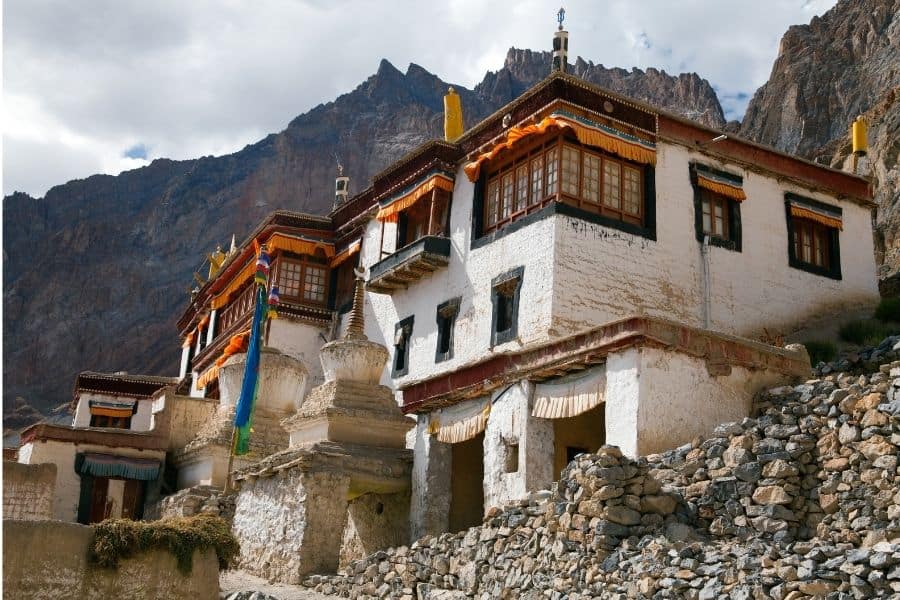Ladakh is a unique part of India, where most people still practice Tibetan Buddhism. The Buddhist monasteries are the main tourist attractions and the best places you can visit in Ladakh. Their locations are jaw-dropping as they cling against the steep rocks amid barren, rugged mountains. The monasteries belong to different monastic orders and are an essential part of the Ladakhi culture. There are hundreds, and you definitely cannot visit all of them. But you may wonder which ones are the most famous monasteries in Ladakh that you must see.
- 1. Hemis monastery – the most famous Buddhist monastery in India
- 2. Chemrey monastery – a small monastery with unique ambience
- 3. Thiksey monastery – the most photographed monastery
- 4. Spituk monastery – famous for the Gustor festival
- 5. Likir monastery – a 25-meter high golden painted Maitreya Buddha statue
- 6. Alchi monastery – stunning Kashmiri-style wall paintings
- 7. Rizong monastery – monks live under the most rigid rules
- 8. Lamayuru monastery – the largest and oldest monastery in Ladakh
- 9. Phuktal monastery – the most isolated monastery in Ladakh
- 10. Diskit monastery – the most famous monastery in Nubra Valley
1. Hemis monastery – the most famous Buddhist monastery in India
Since Naropa, the famous Indian sage founded the monastery in the 11th century, Hemis has been the center of the Kagyü branch of Tibetan Buddhism. It is the largest and most famous gompa in India, where around 500 monks live like hermits. In the 17th century, the Ladakhi king, Sengge Namgyal and his spiritual teacher, Lama Staksang Repa re-established it.
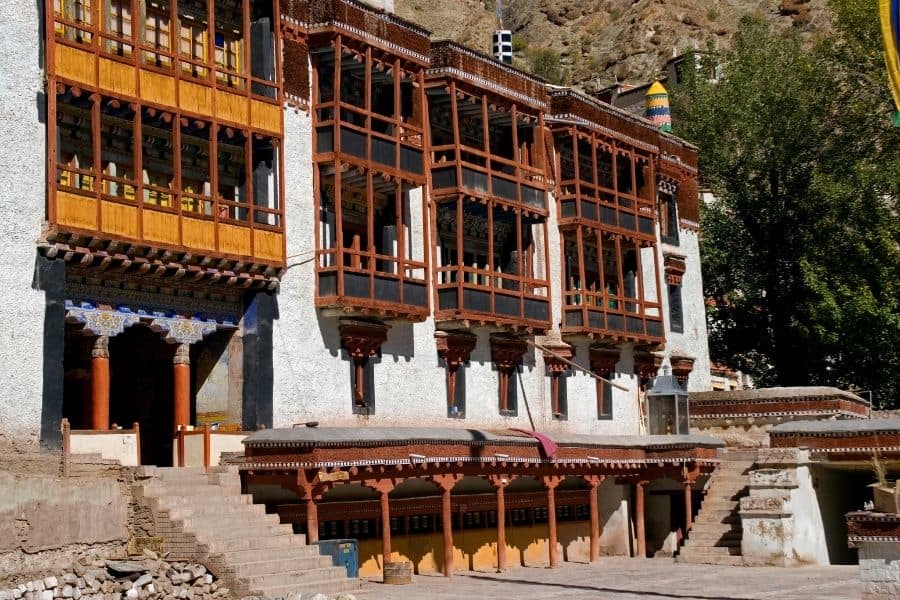
Ladakh’s largest museum is attached to the monastery with precious Thangkas (paintings on silk or cotton that can be rolled up), the statues of Boddhisattvas, ceremonial masks and other objects related to the monastery life. The original monastery was rebuilt in the 1630s. The immense statue of Padmasambhava and the large image of the Sakyamuni Buddha are some of the main attractions.
Read more about Tibetan Buddhism in Ladakh
Hemis gives home to the famous festival in Ladakh to honor Padmasambhava, the founder of the first monastic Nyingma order, in June or July each year. Every twelve years, in the monkey year of the Chinese calendar, they unroll the extra-large thangka, depicting Guru Padmasambhava outside the monastery. Thousands of people gather for this spectacular festival.
Pin it for later!
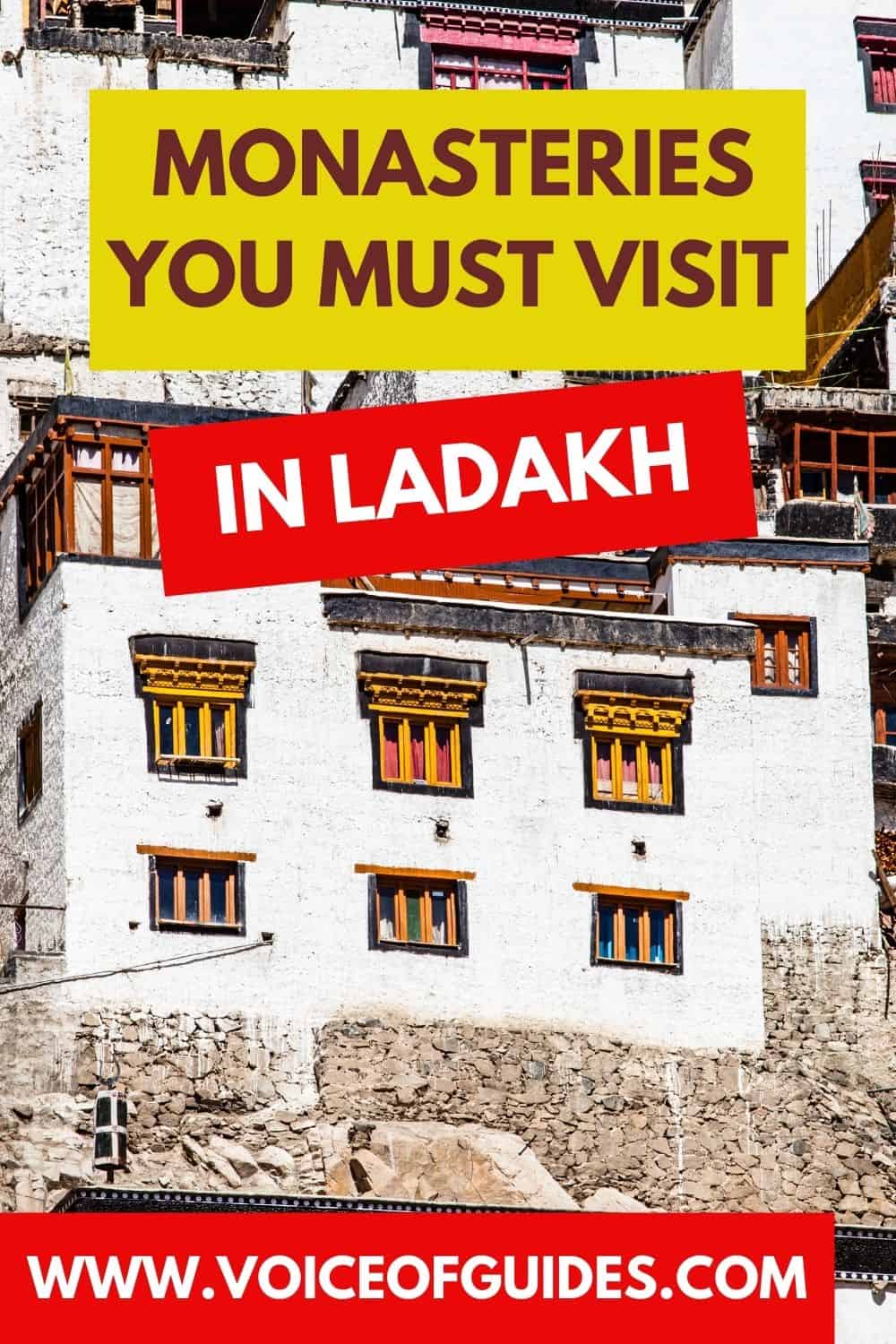
The best two-week Ladakh and Kashmir itinerary
It takes place in the square courtyard in front of the main entrance. They set up two large platforms with a sacred column in the middle. The most esoteric part of the celebrations are the mystical mask (“Cham”) dances performed by monks. You can only witness that in gompas that follow the tantric Vajrayana teachings and the tantric rituals. Monks also play traditional music with dulcimer, drums and trumpets. The Mask dances are core to the Ladakhi culture.
Opening hours: 08:00 am – 06:00 pm
Entrance fee: 100 INR
How to get there: There is one bus per day in summer to Hemis, otherwise you can hire a car with or without a driver.
2. Chemrey monastery – a small monastery with unique ambience
Opposite the Hemis monastery, 47 km southeast of Leh, Chemrey is one of the most attractive monasteries located on the very top of an impressive hill in the center of the valley. The residences of the monks occupy the hillside till the bottom. This stunning gompa is only 8 km from Karu where you can find guesthouses. It is the most important branch of the Hemis monastery of the Kagyupa sect dedicated to the Sengge Namgyal ruler.
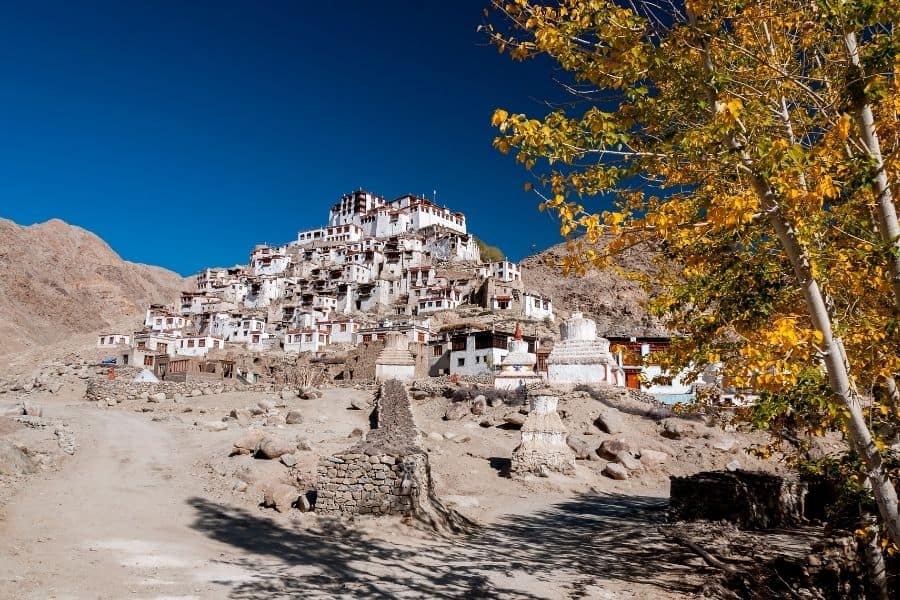
The main Chemrey Angchok festival held on the 28th and 29th day of the ninth month of the Tibetan calendar usually falls in November. The monastery is decorated with colorful flags and Cham dances are performed. The large statue of Padmasambhava and ancient scriptures are the most valuable part of the complex.
How to get there: Only possible with a taxi
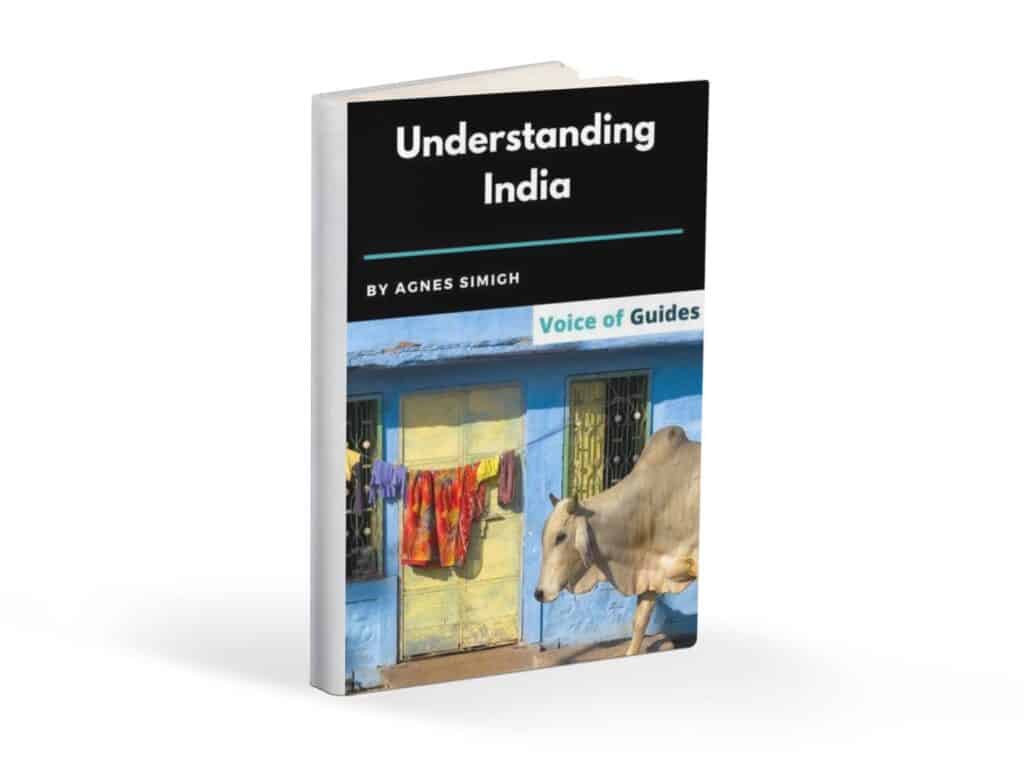
3. Thiksey monastery – the most photographed monastery
Thiksey is the monastery that you see the most often in photographs. It became the second most important monastery after Hemis, located 19 km from Leh.
It looks stunning as the monk residences cover the steep hillside. The entire structure resembles the world-famous Potala Palace in Tibet. It was founded in the mid-15th century by two emissaries of Tsong Khapa, the founder of the Gelug monastic order. The location of the buildings reflects their significance.
The best two-week Ladakh and Kashmir itinerary
The living quarters are on the lower level, whereas the monastery, the stupas and the official seat of the head lama are on the top.
The 12-meter-high gold-painted Maitreya statue wears a golden crown in a sitting position, which is a striking element of the complex. It was consecrated by the Dalai Lama in 1980.
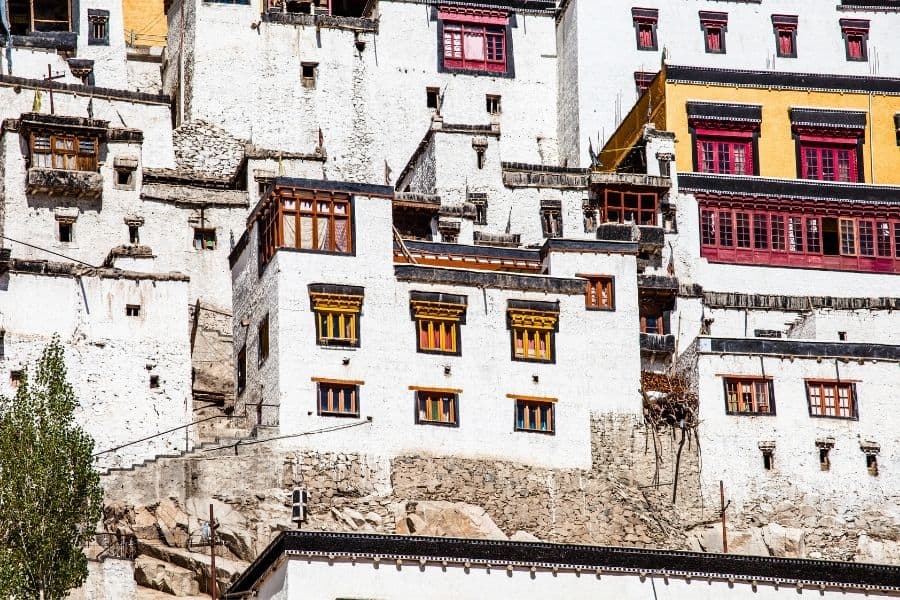
Approximately 100 monks live and meditate in the Thiksey monastery. Early morning visitors can observe their traditional rituals.
From the top, there is an amazing panorama of Stok, Shey and Matho monasteries. There are ten churches, two assembly halls, chortens, and a rich collection of Buddhist art treasures, like thangkas and mural paintings.
The Gonkhang, the protectors’ temple, is full of statues of wrathful dieties. Women cannot enter the Lamokhang temple, a school where young boys get lectures to become lamas.
Like Thiksey, it organizes the spectacular Gustor Festival in October-November, where monks perform the famous Ladakhi Cham dances accompanied by the dulcimer, old horns, bells, and shells.
Entrance fee: 20 INR
Opening hours: 07:00 am – 07:00 pm
How to get there? Thiksey is the easiest to reach by public bus, but a taxi is always the most convenient.
4. Spituk monastery – famous for the Gustor festival
Spituk is only 8 km from Leh along the highway to Srinagar. Those who arrive by plane in Leh will fly over the gompa that is one of the most famous in Ladakh. The Spituk Gompa is a mix of older and newer temples, some of which were only added in the 1970s. It currently belongs to the Gelug monastic order.
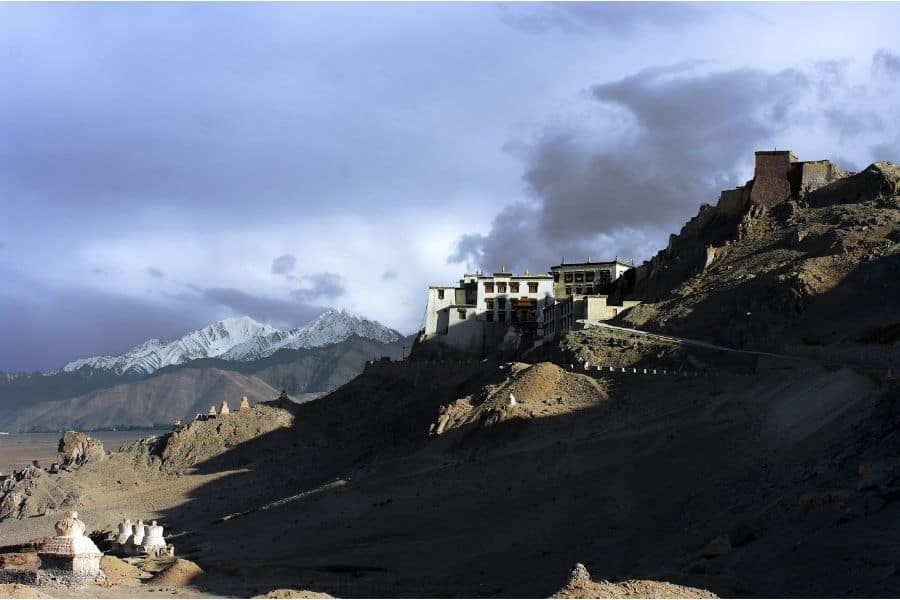
Approximately 125 monks are registered to Spituk, but half of them live in Sankar, Stok and Sabu. The gompa is famous for the statue of protector deity Palden Lhamo. The annual Gustor festival takes place from the 27th to 29th day in the eleventh month of the Tibetan calendar in May or June, when all the monks gather to celebrate with famous mask dances. On the second day of the festival, they burn the human figure made from dough and dismember it with a ritual weapon as a symbol of killing the enemy. Later, another effigy, symbolizing even stronger evil forces, is burnt with noisy celebration.
The gompa houses a 7-meter-high Sakyamuni Bodhisattva statue and has some extremely valuable Thangkas brought from the Potala Palace in Lhasa during the Chinese invasion.
The best two-week Ladakh and Kashmir itinerary
They built a memorial for the highly respected Rinpoche (head lama) of the monastery, Kushok Bakula Rinpoche, who died in 2003. He was previously a member of parliament and the Indian Ambassador to Mongolia. His reincarnation is the current Rinpoche.
Entrance fee: 20 INR
Opening hours: 6am-1pm & 1.30-6pm
How to get there: Take a bus directly to Spituk or Lamayuru and get off. It is relatively close to the main road.
The most convenient is to take a taxi as you could visit more monasteries in one day.
5. Likir monastery – a 25-meter high golden painted Maitreya Buddha statue
The monastery of the Gelug sect has a stunning location atop the hill 53 km west of Ladakh. It is the seat of Ngari Rinpoche, the youngest brother of the Dalai Lama. As the monastery has a close connection to the Dalai Lama, a throne is set aside exclusively for his visit.
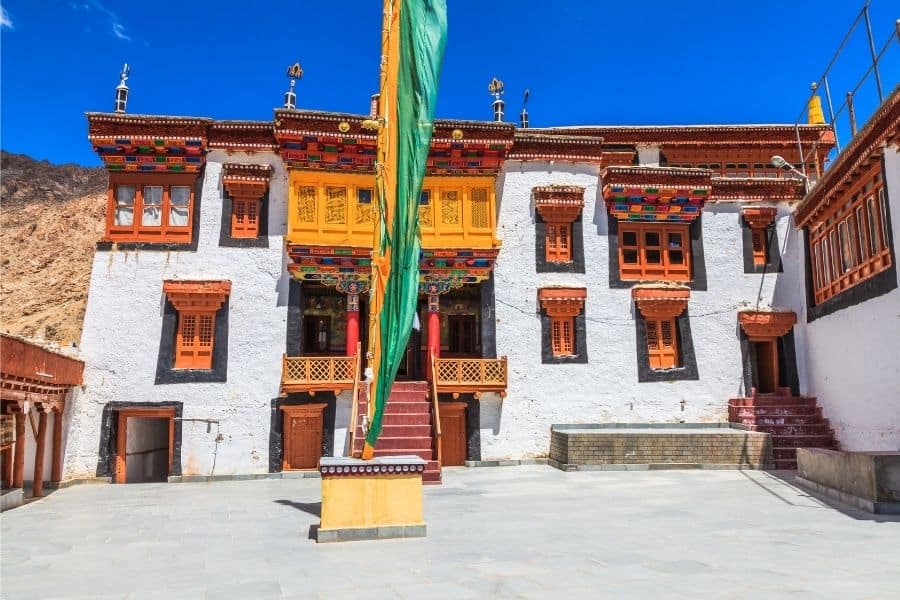
Another striking element of the complex is the 25-meter-high golden painted sitting Maitreya Buddha statue inaugurated in 1999.
The gompa dates to the 11th century and approximately 100 monks spend their lives here. Thankas, the artistic rolled-up paintings, the images of guardian divinities, Sakyamuni Buddha and Tsong Khapa are the most valuable part of the interior decoration.
The Likir monastery gives home to a school administered by the Central Institute of Buddhist studies. A library is also open to visitors with ancient manuscripts and books on Buddhism.
Likir also celebrates an annual festival with the spectacular mask dances performed by the monks.
The annual Likir Monastery festival in February is the most exiting event, which includes Cham dances performed by lamas.
Entrance fee: 30 INR
Opening hours: 6:00 AM – 1:00 PM and 1:30 PM – 6:00 PM
How to get there: You can take a bus to Lamayuru and get off at the junction that leaves another 5 km to walk. The most convenient is to take a taxi and visit more monasteries a day.
You can book a combined tour to visit Likir and Alchi monastery here
6. Alchi monastery – stunning Kashmiri-style wall paintings
Alchi is one of the most unique and oldest monasteries in Ladakh from the 11th century that belongs to the Gelug sect. Unlike other monasteries, it was built on a flat area as it preceded the invasions of the 15th century. Alchi is one of the 108 monasteries constructed by Rinchen Zangpo Indian scholar in the 10th century, some of which are in Nepal, Bhutan, and Tibet and are crucial to Tibetan Buddhism. As you approach it through the bazaar, there is a marked tree on the right side. It is believed to have grown from the original walking stick of Rinchen Zangpo. There are a series of chortens before the main gateway.
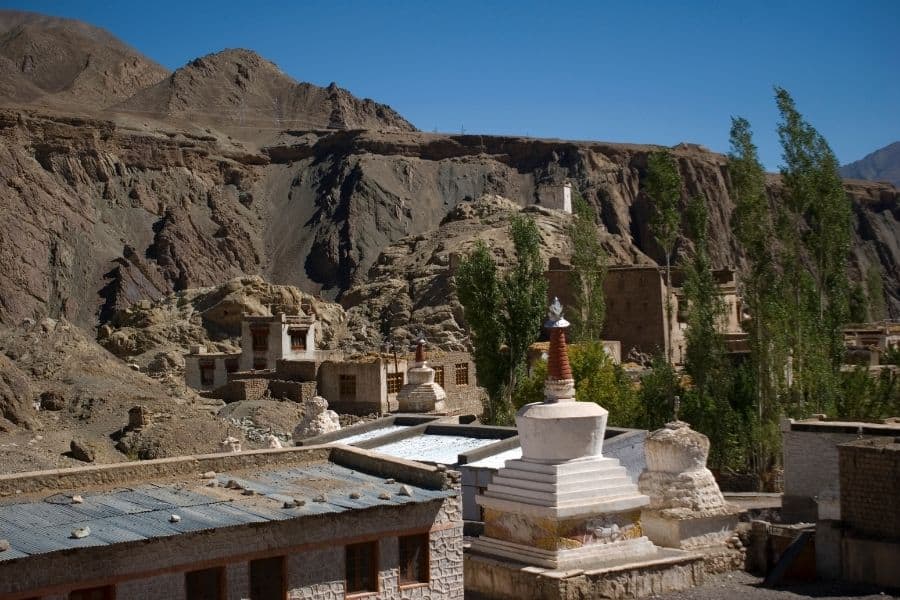
He commissioned Kashmiri artists to prepare the murals. Although some of them were destroyed, the assembly and praying halls of Alchi still showcase the distinct Kashmiri-style paintings. The murals reflect the Buddhism and Hinduism of Kashmir and Himachal Pradesh at that time. These are some of the oldest surviving murals in Ladakh.
The assembly and prayer halls with the thousand Buddha frescoes, the wheel of life, Mahakala and Mandala paintings, large Buddha statues and beautiful wood carvings are the most impressive parts of the gompa.
Entrance fee: 25 INR
Opening hours: 10:00 am – 06:00 pm
How to get there: In summer there are daily buses to Alchi. Alternatively, you can take the bus to Lamayuru, get off at the junction and hitchhike the last couple of kilometers. Or take a taxi and combine your visit to Alchi with other monasteries.
7. Rizong monastery – monks live under the most rigid rules
Rizong is one of the most isolated monasteries in Ladakh. A steep path leads up into a maze of buildings through the upper chapels and courtyards. There is no village around, which means that there is no accommodation at all. It was founded around 1840 and belongs to the Gelug order, the yellow hats. Rizong is some kilometers from the Leh-Lamayuru road nestled between towering rocks that let only a little sunshine into the gorge. In winter, the monastery often gets cut by the snow.
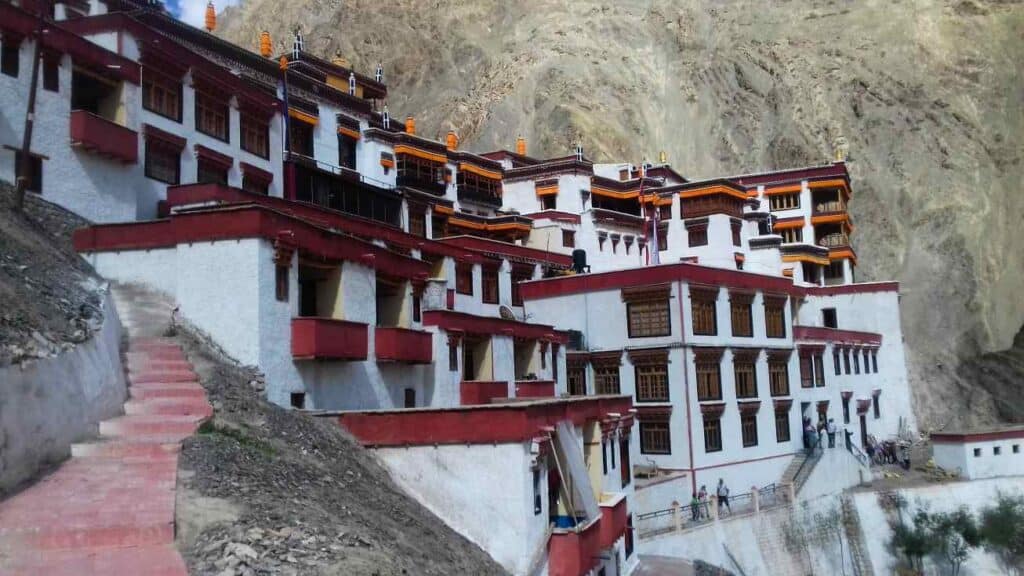
Earlier, lamas used to meditate for years in nearby caves. They ate once a day, which the locals gave them through the small holes of the cave. The monastery is famous for its particularly rigid rules:
– the monks are not allowed to leave except for illness.
– they cannot sleep in a bed
– they must not touch anything that was touched by a woman before
– before sunrise and after sunset, they can only leave the cell to bring water
-they cannot even own a needle
– they cannot light a fire in their room
Disobedient monks may be expelled from the monastery for any offense
The lamas of Rizong follow the rules so strictly that they do not take part in mask dances and other dance rituals.
The monastery is also different in that it has two lamas, Tsultrin Nyima, the founder and his son Sras Rinpoche. Around 40 monks and 26 nuns live in Rizong. They work all day to provide for the monks
2 km away, there is a nunnery that belongs to the monastery. The young and more educated learn Tibetan philosophy. They milk the cows, and extract the oil from the apricot kernel. Most nuns work from morning till evening and have no time for spiritual life.
Entrance fee: free of cost
Opening hours: Open every day from June till September
How to get there: There is no direct bus to Rizong. You can take the bus to Lamayuru and get off along the road. From the junctions, it is a one-hour walk to reach Rizong.
8. Lamayuru monastery – the largest and oldest monastery in Ladakh
It is the largest and oldest monastery in Ladakh. Once called Yungdrung, which means svastika, the symbol of the pre-Buddhist Bon faith. More than 1000 years ago, before Buddhism spread in Ladakh, Lamayuru was the center of the pre-Buddhist „bon” religion. A unique thing about Lamayuru is the moon-like landscape that surrounds it.
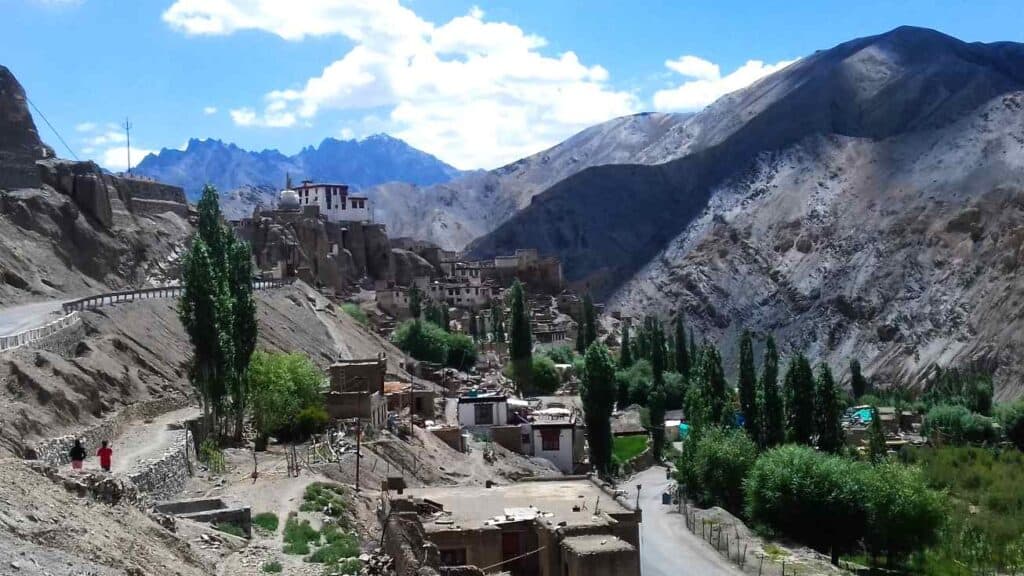
Today, it is one of two major Drigung Kagyupa gompas in Ladakh, where 200 monks live. The oldest part of the monastery dates back to the 11th century. It is one of the 108 monasteries built by the Indian scholar Rinchen Zangpo. Lamayuru also marks the border between the Muslim and Buddhist regions in Ladakh. In early times, more than 500 monks lived here. They studied, observed, and practiced the teachings of the Buddha. In 1834, the Dogra Hindu troops occupied Ladakh and slaughtered most monks, while the rest fled into the mountains. The monastery lay in ruins, and the main sanctuary became a horse stable. The invaders used the doors and windows as firewood and put the priceless scripts on fire. The gompa was destroyed, but thanks to donations, within two years, they rebuilt it.
The best two-week Ladakh and Kashmir itinerary
Lamayuru was always a special place. The king of Ladakh and the Baltics enacted a law that whatever he committed, any criminal would escape execution, who personally sends his hat to Yungdrung Tharpaling before the day of sentencing. This is why it was also known as “Tharpaling”, the land of liberation, Yungdrung Tharpaling or Lamayuru. The ruler of Kashmir also passed the law that nobody can fight in Lamayuru, the holy place. It always enjoyed a special status in Ladakh.
Entrance fee: 30 INR
Opening hours: 06:00 am – 06:00 pm
How to get there: There are direct buses in summer from Leh that take 6 hours to Lamayuru. It is much more convenient and faster to hire a taxi and visit more monasteries on the way.
9. Phuktal monastery – the most isolated monastery in Ladakh
Phuktal, the Gelug monastery, lies deep in the remote part of Zanskar valley with 70 monks. If you want to get there, you need to make an effort. There is no direct road to the monastery that clings against a nearly vertical cliff. It is hard to understand how locals managed to construct something like that in the 12th century. The whole structure was built around a natural cave, where monks, scholars, and translators came to live in solitude and meditate.
One of the caves preserves the remains of the founder, Tserap Zangpo. Donkeys and horses carry the supply up to the monastery in the summer, while in wintertime, they transport everything on the frozen Zanskar lake. The prayer hall, temple, kitchen, and the private residences of monks are an integral part of it. A memorial slab is a reminder that Alexander Csoma de Kőrös, who compiled the first English-Tibetan dictionary, lived here between 1827-1828.
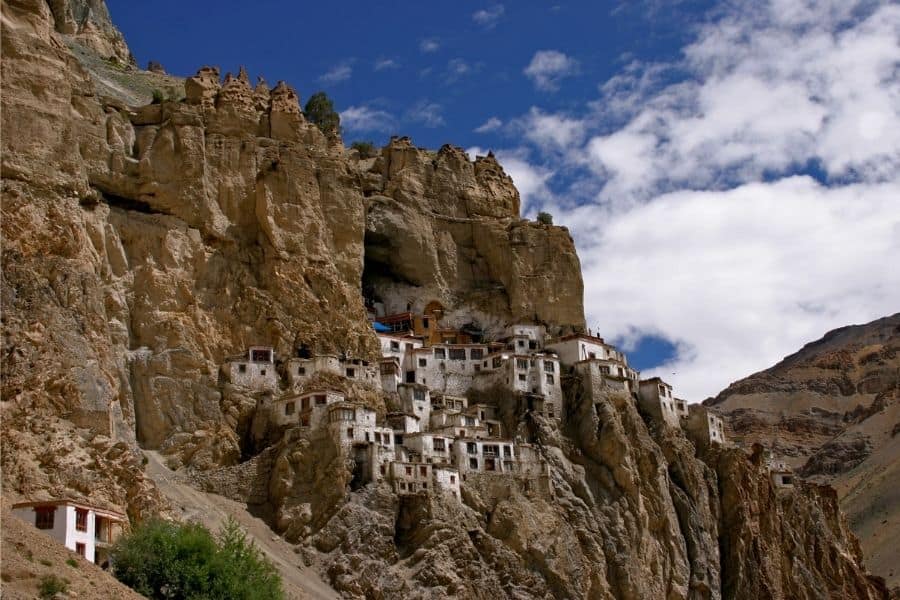
Entrance fee: free of cost
Opening hours: 6am-1pm & 1.30-6pm
How to get there: from Padum, it is a 3-4 days trek to reach Phuktal. The nearest places are Cha or Khansaar villages along the route to Padum. From there, it is a day’s walk.
10. Diskit monastery – the most famous monastery in Nubra Valley
A series of chortens, stupas and mani walls along the stepped path leading to the gompa, where 70 monks of the Gelugpa sect live and study. Diskit is the principal religious and administrative center of the Nubra Valley, ca. 150 km from Leh, and an important branch of the Thiksey monastery.
The Dalai Lama is a frequent visitor in the more than 500-year-old monastery founded by a disciple of Tsong Khapa, Tserab Zangpo. A school with children aged between 7-16 also belongs to the complex.
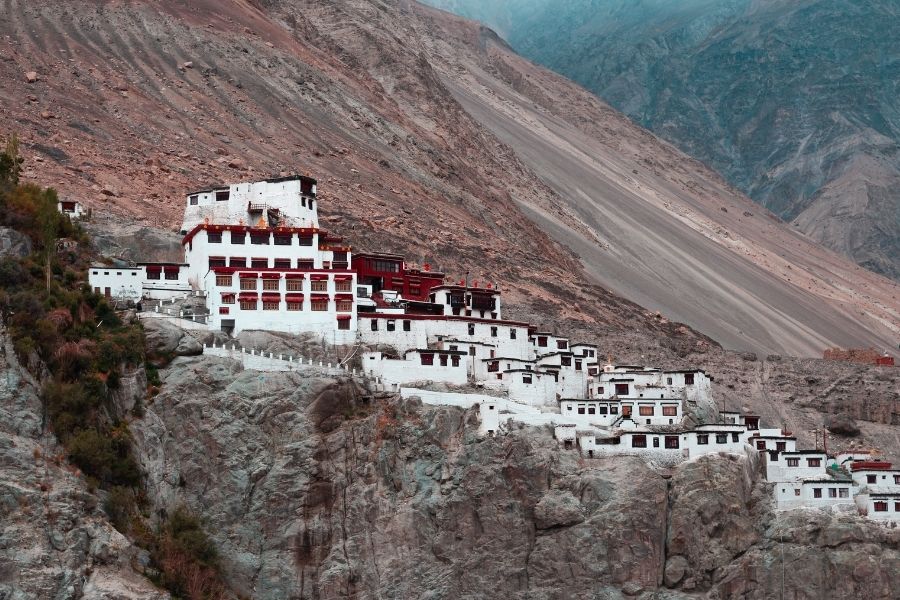
Another highlight of the monastery is the 32-meter high statue of Maitreya Bodhisattva decorated with 8 kg of gold below the monastery on top of the hill. The Dalai Lama consecrated it in July 2010. The Bodhisattva watches over the valley of the Syok river while facing Pakistan. They say that the statue is meant to protect Diskit village, prevent further war with Pakistan, and promote world peace.
Important: To visit the Nubra Valley, you need to get a travel permit a couple of days in advance at a local travel agency in Leh. A private vehicle is the best choice to go, but there are also buses in summer.
Entrance fee: 30 IRR
Opening hours: 07:00 am-01:00 pm and 02:00 pm- 07:00 pm
The Tibetan Buddhist monasteries are the best places to visit in Ladakh. Apart from the most famous monasteries, many others are worth the visit, including Shey monastery, Takhtok, Stakna, Phyang, Matho, or Karsa. Every gompa has some unique feature. Whichever you visit, it will impress you.
Useful resources for your travel to India
Insurance: Safetywing insurance that covers COVID-related issues as well.
Train, bus and flight ticket: Book your train ticket at Indian Railways website, or 12Go which gives you the best option (train, bus, and flight) based on the city of departure or arrival.
For your flight ticket use Google Flights.
Accommodation: Booking.com and Hostelworld.com offer a wide choice of low and higher-budget hotels.
Local tours and tour packages: Viator and GetYourGuide offer transfers and several one or multi-day tours.

